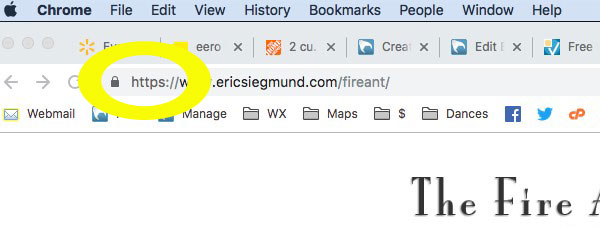It was a dark and stormy night…
Now that I have your undivided attention, allow me to explain why I’ve completely blown my [admittedly never before publicized, for obvious reasons] goal of posting something every five days or so during 2019. This was not — NOT — a New Year’s resolution; it was purely coincidental that my resolve to write more reached its apex on January 1st. Anyhoo…
While I’ve not put anything new on the Gazette in lo these many days, I have still been hard at work on your behalf, toiling mightily behind the scenes to address some rather embarrassing breaches in this blog’s stellar reputation for quality content.
You see, it came to my attention that a very few [*cough* about a hundred *cough*] of my prior posts contained links to videos that no longer work. The upshot of this stunning revelation is that when you looked at an article that referenced, say, a baby squirrel dancing a tango with a roller-skating nun* all you would see is the following:
This is, as they say, a sub-optimal situation. However, it’s not my fault. Well, not entirely. OK, it’s completely my fault but I have an excuse: I’m clueless, and shouldn’t be held to such high standards of competency. Here’s what happened.
YouTube first appeared on the interwebz with a zoo-related video uploaded in April, 2005. Those first YouTube videos were in Flash format (*spit*). It took almost twenty months before the first Gazette post featured a YouTube video — don’t bother looking for it; it’s been deleted from the site, and the post itself no longer appears here, either — so no one can accuse me of being an early adopter. I was sure that silly fad of moving pictures would quickly fade away.
Vimeo came along around that same time (I was unsuccessful in finding out when the first video was uploaded…Google is such a disappointment to us serious researchers), and it also employed Flash for its playback technology.
However, in response to a combination of browser evolution and security/performance issues with Flash, both services began offering non-Flash alternatives to its videos, adhering to HTML5 standards. The technical implications are not really important for the purpose of this excuse, uh explanation…just that the user experience on both platforms was changed for the better when Flash was dumped. But, the upshot was that the coding on websites where videos were embedded no longer worked.
More recently, most major browsers stopped supporting webpages with “mixed content.” This is is a little more complicated to explain. Most of you are familiar with the the concept of a secure webpage, right? So whenever you visit a website, and you see the little lock icon up by the URL (as shown below), you know that your interface with the server on which that site resides is encrypted and thus safer from hacking or “eavesdropping” than a site without it. So, in order for a webpage to get that little lock icon, everything on the page — all the images, and videos, and audio files, scripts, etc. — must also originate from secure servers.

Your browser may display the lock icon a little differently; this is on Google Chrome
But sometimes, even though the main webserver is secure, some of the content on the page you’re viewing may not be. The page is then said to contain mixed content. And the vulnerability of that page to outside malfeasance varies depending on the type of that insecure content, to the point where the major browsers now actually prevent it from appearing, even when the rest of the page does appear. Embedded videos that aren’t delivered from an HTTPS site fall into that category. I’m oversimplifying but that’s the gist of it. And eventually, browsers will probably block ALL non-secure content, but that’s another story.
This is a long, tedious way of saying that a bunch of the videos that I had embedded in blog posts were not delivered by way of a secure server and so they were not showing up. The fix is very simple — just add an “s” to the “http” in the URL and — voila! — baby squirrels doing cute things now appear as before. Sounds simple, but it’s not something I could do with a global edit command (or if it is, I don’t know how to do it, which is very possible).
So I ended up going through several years of posts, one-by-one, looking for blanks where embedded videos should have been. In some cases, the original videos had actually been deleted from YouTube or Vimeo, or the URLs had changed and I had to track them down via a search, but for the most part the addition of that one letter was all that was needed. At some point both YouTube and Vimeo began using https:// in all of their embedding coding so I didn’t have to look at everything, but I still crawled through about five years of Fire Ant drivel, all to maintain the artistic integrity of something that no one will likely ever look at again anyway. But it’s now there, in case alien historians investigate possible causes for the human race’s extinction due to sheer boredom.
*There’s probably no such video. Seriously, do not spend time looking for it.
Discover more from The Fire Ant Gazette
Subscribe to get the latest posts sent to your email.
